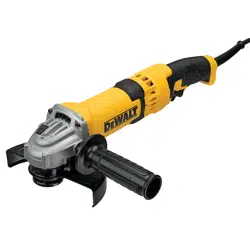Loading ...
Loading ...
Loading ...

English
4
excessive accumulation of powdered metal may cause
electricalhazards.
n ) Do not operate the power tool near flammable
materials. Sparks could ignite thesematerials.
o ) Do not use accessories that require liquid
coolants. Using water or other liquid coolants may
result in electrocution orshock.
p ) Do not use Type 11 (flaring cup) wheels on this
tool. Using inappropriate accessories can result
ininjury.
q ) Always use side handle. Tighten the handle
securely. The side handle should always be used to
maintain control of the tool at alltimes.
r ) When starting the tool with a new or
replacement wheel, or a new or replacement
wire brush installed, hold the tool in a well
protected area and let it run for one minute. If
the wheel has an undetected crack or flaw, it
should burst in less than one minute. If the wire
brush has loose wires, they will be detected.
Never start the tool with a person in line with the
wheel. This includes theoperator.
s ) Use of accessories not specified in this manual
is not recommended and may be hazardous.
Use of power boosters that would cause the tool
to be driven at speeds greater than its rated speed
constitutesmisuse.
t ) Use clamps or another practical way to secure
and support the workpiece to a stable platform.
Holding the work by hand or against your body leaves
it unstable and may lead to loss ofcontrol.
u ) Avoid bouncing the wheel or giving it rough
treatment. If this occurs, stop the tool and inspect the
wheel for cracks orflaws.
v ) Always handle and store wheels in a carefulmanner.
w ) Do not operate this tool for long periods of time.
Vibration caused by the operating action of this
tool may cause permanent injury to fingers,
hands, and arms. Use gloves to provide extra
cushion, take frequent rest periods, and limit daily
time ofuse.
x ) Air vents often cover moving parts and should be
avoided. Loose clothes, jewelry or long hair can be
caught in movingparts.
Causes and Operator Prevention
of Kickback
Kickback is a sudden reaction to a pinched or snagged
rotating wheel, backing pad, brush or any other accessory.
Pinching or snagging causes rapid stalling of the rotating
accessory which in turn causes the uncontrolled power tool to
be forced in the direction opposite of the accessory’s rotation
at the point of thebinding.
For example, if an abrasive wheel is snagged or pinched by
the workpiece, the edge of the wheel that is entering into the
pinch point can dig into the surface of the material causing
the wheel to climb out or kick out. The wheel may either jump
toward or away from the operator, depending on direction
of the wheel’s movement at the point of pinching. Abrasive
wheels may also break under theseconditions.
Kickback is the result of tool misuse and/or incorrect operating
procedures or conditions and can be avoided by taking proper
precautions as given below:
a ) Maintain a firm grip on the power tool and
position your body and arm to allow you to resist
kickback forces. Always use auxiliary handle, if
provided, for maximum control over kickback or
torque reaction during start up. The operator can
control torque reaction or kickback forces, if proper
precautions aretaken.
b ) Never place your hand near the rotating
accessory. Accessory may kickback over yourhand.
c ) Do not position your body in the area where
power tool will move if kickback occurs. Kickback
will propel the tool in direction opposite to the wheel’s
movement at the point ofsnagging.
d ) Use special care when working corners, sharp
edges etc. Avoid bouncing and snagging the
accessory. Corners, sharp edges or bouncing have a
tendency to snag the rotating accessory and cause
loss of control orkickback.
e ) Do not attach a saw chain woodcarving blade
or toothed saw blade. Such blades create frequent
kickback and loss ofcontrol.
Safety Warnings Specific for Grinding and
Abrasive Cutting-Off Operations
a ) Use only wheel types that are recommended for
your power tool and the specific guard designed
for the selected wheel. Wheels for which the power
tool was not designed cannot be adequately guarded
and areunsafe.
b ) The grinding surface of center depressed wheels
must not be mounted below the plane of the
guard lip. An improperly mounted wheel that
projects through the plane of the guard lip cannot be
adequatelyprotected.
c ) The guard must be securely attached to the
power tool and positioned for maximum safety,
so the least amount of wheel is exposed towards
the operator. The guard helps to protect the operator
from broken wheel fragments, accidental contact with
wheel and sparks that could igniteclothing.
d ) Wheels must be used only for recommended
applications. For example: do not grind with the
side of cut-off wheel. Abrasive cut-off wheels are
intended for peripheral grinding, side forces applied to
these wheels may cause them toshatter.
e ) Always use undamaged wheel flanges that
are of correct size and shape for your selected
wheel. Proper wheel flanges support the wheel
thus reducing the possibility of wheel breakage.
Flanges for cut-off wheels may be different from
grinding wheelflanges.
Loading ...
Loading ...
Loading ...
